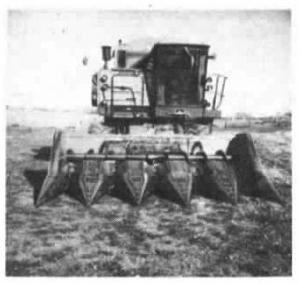He Increased Combine Capacity 25 Percent
 ✖  |
"Last fall when I was combining corn a neighbor was riding along with me in the field. His head just kept going left and right like he was watching a tennis match, counting and recounting the number of rows on my corn head," says Charles Marshall, who replaced the 4-row head on his Deere 6620 combine with a.5-row head he rebuilt by reworking a Deere 643 6-row (30-in.) header.
"I wanted to increase the capacity of my combine and I felt this was the easiest way to go," says Marshall, of Stronghurst, Ill. "I couldn't find a Deere 5-row header and even if I had been able to find one, I didn't feel I could justify the price. I could also have changed from 36-in. rows to 30-in. rows, but I felt it was uneconomical to change planters, cultivators and my corn head. Besides, I like 36-in. rows."
Marshall says harvesting an extra row has boosted combine capacity 25%. "It works better than I'd dreamed," he says. "You can easily gain 10 acres a day."
Plus, the new head saves wear and tear on implement tires since he no longer has to drive on top of rows but can go between them. Also, because he's no longer crushing corn stalks by driving on rows, his beef cows have more stalks to graze on over winter. And he always has a spare header handy in case of a breakdown.
To convert the Deere head, which Marshall bought for $3,000, to five rows, he first stripped the six snouts and tin off. Then he removed one of the center row units and moved the remaining five row units toward the middle so they'd conespond with his 36-in. rows, centering the units off what became the new center unit.
Marshall spread the rows out by bolting 6-in. steel spacer bars onto the header at the top of each row unit.
Because he widened row spacings, Marshall had to stretch one of the head's two drive shafts by 14-in. On the original head, each drive shaft operated three rows. Now the longer drive shaft runs three rows; the original, two rows.
To complete the conversion, Marshall attached new divider snouts he made out of steel tapered from 6-in. in the rear to a point in front.
"The only parts I had to purchase were the shields underneath the row units, which were for 30-in. rows," he says. "I got five shields for 36-in. rows for $20 from a salvage yard."
Including replacing worn gathering chains and snap rollers with new ones, converting the head took about two days, Marshall says. It cost about $200 in parts and materials.
Contact: FARM SHOW Followup, Charles Marshall, Box 137, Stronghurst, Ill. 61480 (ph 309-924-1155).

Click here to download page story appeared in.
Click here to read entire issue
He Increased Combine Capacity 25 Percent COMBINES Headers 19-1-33 "Last fall when I was combining corn a neighbor was riding along with me in the field. His head just kept going left and right like he was watching a tennis match, counting and recounting the number of rows on my corn head," says Charles Marshall, who replaced the 4-row head on his Deere 6620 combine with a.5-row head he rebuilt by reworking a Deere 643 6-row (30-in.) header.
"I wanted to increase the capacity of my combine and I felt this was the easiest way to go," says Marshall, of Stronghurst, Ill. "I couldn't find a Deere 5-row header and even if I had been able to find one, I didn't feel I could justify the price. I could also have changed from 36-in. rows to 30-in. rows, but I felt it was uneconomical to change planters, cultivators and my corn head. Besides, I like 36-in. rows."
Marshall says harvesting an extra row has boosted combine capacity 25%. "It works better than I'd dreamed," he says. "You can easily gain 10 acres a day."
Plus, the new head saves wear and tear on implement tires since he no longer has to drive on top of rows but can go between them. Also, because he's no longer crushing corn stalks by driving on rows, his beef cows have more stalks to graze on over winter. And he always has a spare header handy in case of a breakdown.
To convert the Deere head, which Marshall bought for $3,000, to five rows, he first stripped the six snouts and tin off. Then he removed one of the center row units and moved the remaining five row units toward the middle so they'd conespond with his 36-in. rows, centering the units off what became the new center unit.
Marshall spread the rows out by bolting 6-in. steel spacer bars onto the header at the top of each row unit.
Because he widened row spacings, Marshall had to stretch one of the head's two drive shafts by 14-in. On the original head, each drive shaft operated three rows. Now the longer drive shaft runs three rows; the original, two rows.
To complete the conversion, Marshall attached new divider snouts he made out of steel tapered from 6-in. in the rear to a point in front.
"The only parts I had to purchase were the shields underneath the row units, which were for 30-in. rows," he says. "I got five shields for 36-in. rows for $20 from a salvage yard."
Including replacing worn gathering chains and snap rollers with new ones, converting the head took about two days, Marshall says. It cost about $200 in parts and materials.
Contact: FARM SHOW Followup, Charles Marshall, Box 137, Stronghurst, Ill. 61480 (ph 309-924-1155).
To read the rest of this story, download this issue below or click
here to register with your account number.







